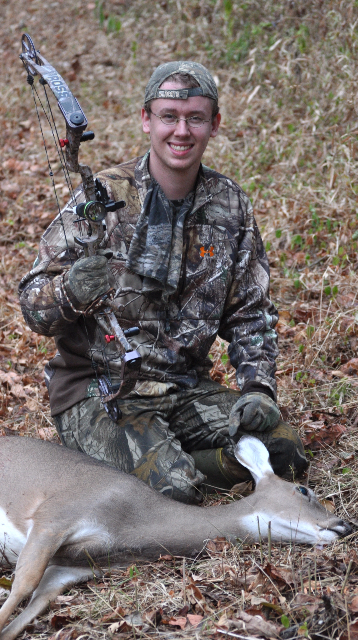Author Art Lander Jr.
July 7, 2011
FRANKFORT, Ky. – Bowhunter education is not mandatory here, but it’s likely that more Kentuckians who hunt with archery equipment will want to take the course in the future.
“Our focus is on offering more opportunities for certification,” said Bobby McKee, state bowhunting education coordinator for the Kentucky Department of Fish and Wildlife Resources.
Each year in Kentucky, hundreds of thousands of boys and girls are involved in the National Archery in the Schools Program (NASP), which teaches target archery in physical education class. Many schools have teams that compete in local, district and state tournaments.
Later this summer, Kentucky Fish and Wildlife will unveil plans for activities as part of a new pilot program called Explore Bowhunting. This program was created by the Archery Trade Association to introduce 11- to 17-year-old students to archery hunting.

“Right now, we’re training instructors,” said Katie Koontz, Explore Bowhunting coordinator for Kentucky Fish and Wildlife. “We’re going to encourage everyone to take a hunter education course as their next step after leaving our program.”
For more information about the new program or to sign up as a volunteer instructor, visit the Kentucky Fish and Wildlife website fw.ky.gov. Click on the Explore Bowhunting link on the homepage.
One of the main goals of the program is to bolster declining hunter numbers by persuading some of the boys and girls who participated in these youth archery programs to take up bowhunting.
“In every bowhunter education course, I ask if we have any NASP graduates,” said McKee. “And usually we do.”
Bill Balda, hunter education supervisor for Kentucky Fish and Wildlife, said he hopes that new hunters “will take the hunter education course first and get their orange card, then take a four-hour add-on course which includes the field work needed to gain bowhunter education certification.”
The bowhunter education course can also be taken online through the website of the National Bowhunter Education Foundation (NBEF). The link is: www.bowhunter-ed.com/Kentucky/.
“There’s no cost to study, but after you pass the online course there’s a $30 fee paid to NBEF,” said McKee. “Be sure to print out the field day qualifier certificate.”
Everyone who passes the bowhunter education course, either online or in a class taught by an instructor, must participate in a field day to gain certification. “The students shoot different types of bows, estimate shooting distances, climb treestands, learn about proper arrow placement and game tracking skills and familiarize themselves with all the equipment used in bowhunting,” said Balda.
Archers can take the course in Kentucky and hunt in a state where bowhunter education certification is mandatory. Certification in one state is honored by all the other states in the U.S. and the 10 provinces of Canada.
“A bowhunter education course may be taken in all 50 states and about 12 foreign countries, and is mandatory in 11 states,” said Marilyn Bentz, executive director of the National Bowhunter Education Foundation. “Other states require bowhunter certification if hunting on special areas such as urban hunts or on state or federal lands. As always, it is wise to check your state and local regulations.”
In Kentucky, persons hunting strictly with archery equipment may carry a bowhunter education certification card in lieu of the hunter education orange card.
Some topics addressed in the bowhunter education course include: hunter ethics and responsibilities, the field care of game, wildlife conservation, identifying wildlife species, archery equipment and set-up for hunting, effective shooting distances and treestand safety.
For information on where to take a bowhunter education course in Kentucky, visit the department’s website at: fw.ky.gov. Click on Education and Outdoor Activities on the homepage and follow the links.
Author Art Lander Jr. has been writing about the outdoors since the 1970s. He is a staff writer for Kentucky Afield Magazine.
-30-
to Contact: Art Lander, Jr.
1-800-858-1549, ext. 4414
The Kentucky Department of Fish and Wildlife Resources manages, regulates, enforces and promotes responsible use of all fish and wildlife species, their habitats, public wildlife areas and waterways for the benefit of those resources and for public enjoyment. Kentucky Fish and Wildlife is an agency of the Tourism, Arts and Heritage Cabinet. For more information on the department, visit our website at fw.ky.gov.



Be the first to comment